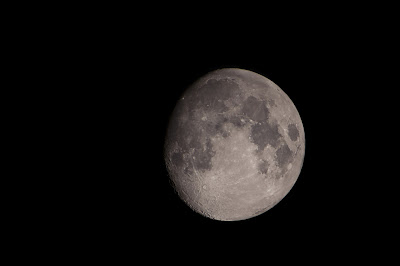 |
| 16 frames stacked in Registax (not cropped, it's just that big at prime focus!) 1/250 sec, ISO 400 |
So I'm learning that the hardest part about prime focus is focusing! With my camera behind a 300mm autofocus lens, I've been cruising through moon photos like nobody's business. At prime focus, however, the telescope is my camera lens, and I have to crank the clunky focuser by hand.
I tried my best to find focus on the moon, and these photos are my result (after stacking to reduce noise). At this scale, I have to basically re-learn how to stack in Registax. I'm used to hand-selecting a few alignment points on a tiny moon, and now I have a whole field of craters and mountains to worry about. I feel like the increased magnification only magnifies the tiny errors in my focusing and processing. Sheesh! Be careful what you wish for.
The diameter of the moon on my photos is now around 1300 pixels compared to 430 pixels. This is good news for future prints! It also means (once I figure out a better way to focus) that I'll have to re-shoot my entire set of moon phase photos. The more you learn, the more steps you add, and the longer it takes to do anything just to squeeze out that extra bit of detail.
While processing this photo, I learned a couple tricks along the way. First is mirror lock-up on my Canon Rebel XT. While I was shooting, I noticed that my heavy camera on the end of a meter-long tube is very unstable. Even the mirror movement when I released the shutter seemed to shake the entire telescope. While I was outside sitting on the grass, I quickly looked up how to mirror lock my camera. I think I'll make that a separate post so hopefully it becomes a useful "how to" for anyone else looking.
Next, to make the moon mountains pop, I tried a new processing trick, Photoshop > Filter > Other > High Pass. I found this YouTube video pretty helpful. Here is the final result...
 |
| 16 images stacked, color and High Pass layer in Photoshop |
No comments:
Post a Comment